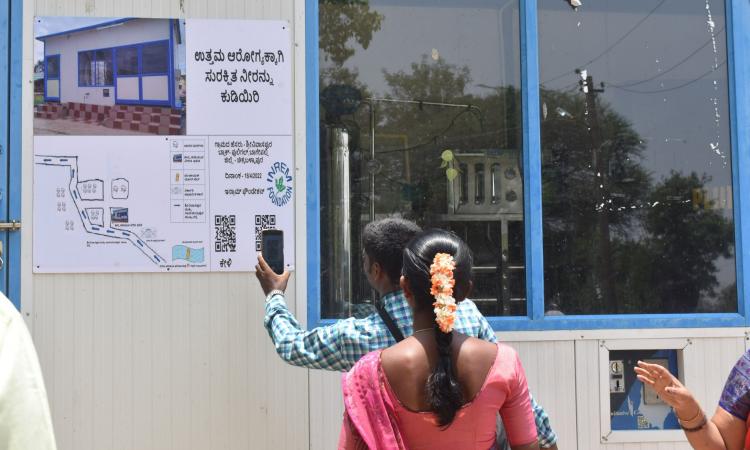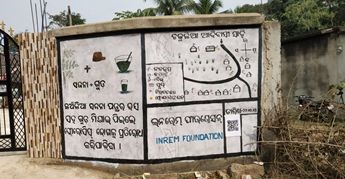
Globally, over 3 billion people are at risk of disease because the water quality (WQ) of their rivers, lakes and groundwater is unknown, due to a lack of data. The Jal Jeevan Mission (JJM) program has rightly emphasized the importance of safe water delivery to every household in the country.
Under JJM, up to 2 percent of total fund allocation to each state is to be used on water quality monitoring and surveillance (WQM&S) activities which primarily comprise water quality monitoring through laboratory testing and water quality surveillance by the community through testing of local water sources using Field Test Kits (FTKs).
In this article, we attempt to make a case for the importance of communicating the precious WQ data to the communities based on observations from Chhattisgarh and Arunachal Pradesh, and the possibilities it can unlock.
Current mechanism for data collection
Water quality testing of drinking water is mostly done in district laboratories managed by public health engineering/rural water supply (PHE/RWS) departments and on the field using field test kits (FTKs) by trained frontline workers using samples from drinking water sources as well as households with functional taps. These tests are generally done thrice a year - one chemical test and, pre and post monsoon bacteriological tests.
Under JJM, the Implementation Support Agencies, members of Village Water and Sanitation Committee (VWSCs), panchayat representatives and five women per gram panchayat have been trained to use FTKs. In Chhattisgarh, the women have been identified as Jal Vahini. Drinking water sources in schools and anganwadis are paid special attention for testing. In areas with fluoride contamination, water from fluoride removal plants are tested as frequently as on fortnightly basis.
Both the laboratory test and FTK results are uploaded onto the Water Quality Management Information System (WQ-MIS) by the District Laboratory staff. If contamination is indicated in FTK, confirmatory tests are done in the district laboratories. Appropriate action is also taken by the department. Moreover, the community, usually the village head, is informed about the contamination. In Arunachal Pradesh, the FTK test results are put on large banners for the community to see and know about their drinking water quality.
The glaring gap in data communication
While testing of drinking water is being done continuously (over 9 million samples have been tested using FTKs and 5.5 million in laboratories as per WQ-MIS), communication of drinking water quality to the communities is only done in case contamination is detected. Currently, there are limited ways for the community members to know whether the water from the drinking water source is safe or not.
What can be done to strengthen data communication?
The community generated data, if communicated back, holds immense opportunity to inspire action on ground by different stakeholders like members of the water supply department, civil society organizations and the consumers themselves. Understanding of the WQ data and its consequences on their health would enable them to take the right measures at household /community level to safeguard their health. We refer to this as data-based participatory governance.
INREM Foundation has been working on communicating and simplifying water quality data, enabling the communities to simply know about the water being consumed by them in the following ways:

1. Reimagined wall paintings: PRA maps of community water sources (handpumps, water purification plants etc.) were painted on a wall with a QR code that can be scanned to access video resources in local languages.
2. Presentation - Direct interaction communicating good practices related to drinking water quality was done with panchayat representatives, CGWB members and community in Chikballapur district of Karnataka.
3. Video communication - Videos of feasible action at the community level have been created and linked to IEC material such as “five-finger concept” and “safe water learning cards.”
4. Data dashboard - WQ data insights dashboard is a solution towards demystifying WQ data by mapping it at different scales through features like contamination hotspots and trends in order to build insights for stakeholders at different levels enabling them to respond to local WQ problems in the form of customized IEC support (Data-to-IEC). The case studies in the next section elaborate on a few plausible uses of the dashboard.

How can communication enable action?
Targeted communication can enable communities to take feasible and effective action. Two such use cases have been elaborated below:
Case 1: A Jal Vahini in a habitation of a district in Chhattisgarh uses Field Test Kits to test water. Some tests indicate iron contamination. She wants to spread awareness about iron in water as well as simple household solutions to treat water. A targeted poster such as one below in the local language can help her to effectively communicate the issue and the solution towards it.

Case 2: An IEC coordinator at the district level in Andhra Pradesh is preparing the communication strategy to effectively communicate WQ data and trigger behavior change for the upcoming financial year . She can use the hotspot feature of the WQ data insights dashboard to plan and develop the context specific material.
Additional Possibilities
Our observations and experience show that the community generated data when communicated back can lead to data-backed decision making, enabling behavior change at the community level. Furthermore, integration with other publicly available data such as MGNREGA, land-use/land change, agriculture etc. can support research and lead to nuanced insights.
Kiran Kumar Sen is the Lead, Technology Integration and Rashika Pullam Chetti is part of the State Programme Team at INREM Foundation.
Neha Pawar is Officer Operations at Arghyam.
/articles/water-quality-data-moving-only-collection-communication